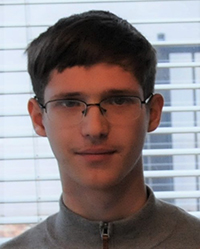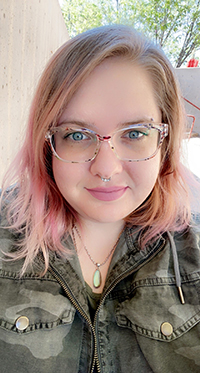Hulsman Undergraduate Library Research Award Winners 2022
The Jim and Mary Lois Hulsman Undergraduate Library Research Award program recognizes excellence in undergraduate research that incorporates the use of University Libraries resources and demonstrates sophisticated information literacy skills. Student award winners receive a cash prize – $500 for 1st place, $300 for 2nd place, $200 for 3rd place – and recognition for their outstanding efforts. Submissions are posted in the UNM Digital Repository.
The College of University Libraries and Learning Sciences sincerely thank UNM Alumni, Jim and Mary Lois Hulsman, for supporting our student recognition and engagement efforts. We are grateful and celebrate Mr. and Mrs. Hulsman for generously donating nearly $1 million to our college since 2007.
Excerpts below are lightly edited.
Advanced Researcher Category
First Place
Etienne G. Allred
SOE and its Contribution to the Allied War Effort during the Second World War
I am from an Air Force family and have lived in 8 different states. It has given me the love of learning about new places and their past. Currently a double major in History and French, I am planning on pursuing graduate school in international affairs with a goal of working in an embassy. My hobbies include collecting stamps and reading French comic books.
Excerpt from Etiennen's submission
Library resources were invaluable to my research on the Special Operations Executive (SOE). An important source for information was the JSTOR database, which I could only access through the UNM library… First, I would find as much information as possible on SOE. Afterwards, I would read through this information and determine what sources were connected or would best suit my main argument. Then, I would look at footnotes within these sources in order to find more information on specific topics… During this process, I learned to carefully evaluate sources in order to see if they were written by experts in the field. To do this, I would look up the author and see whether they were a professor or someone qualified to discuss the history of SOE. This became easier when a person’s work was referenced in multiple reputable sources.
Excerpt from Professor Caleb Richardson letter of support
Etienne’s paper is an important contribution to the histories of intelligence, covert operations, and subversion, areas of study that have attracted renewed attention in recent years… The sources that Etienne consulted for this project included historical monographs and essay collections, scholarly articles, memoirs, historical sources in the digital archives of major British museums, and material from specialist journals in military and intelligence history. Two areas are particularly notable: first, that Etienne employed his fluency in French to seek out French-language sources, and, second, that he utilized audio recordings of oral history interviews of SOE veterans from the Imperial War Museum (first-hand sources in the history of intelligence and covert operations are, for obvious reasons, very hard to come by.) He took full advantage of the resources of UNM Libraries—particularly institutional subscriptions, which allowed him to locate some sources in relatively obscure journals.
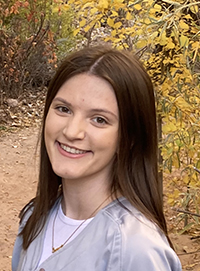 Second Place
Second Place
Mikenzie E. Chessman
Bubonic Plague: Public Health Warnings from an Ancient Disease
Mikenzie is a sophomore studying Population Health. Upon graduation, she hopes to attend UNM's School of Medicine to pursue her MD and MPH degrees. Outside of academics, Mikenzie is a world-qualifying competitive Irish Dancer.
Excerpt from Mikenzie's submission
My research began very generally, searching the UNM Library Database only for terms such as “plague in the 1300s” or “early Bubonic Plague” to locate the areas I would need to pursue further… I narrowed my search with terms more specific to the new information I wished to find, such as “Bubonic Plague primary sources” or “Bubonic Plague and religion.” It was then that I discovered the path that felt perfect for my discussion: public health warnings from an ancient disease. I discovered primary source journals from merchants living in 1300-1400 era Europe, who wrote about the widespread horror consuming their communities. This provided invaluable insight into the immediate effects of the illness on the personal lives and mental health of those impacted by outbreaks that I struggled to locate prior. From recounts of national governments' attempts to enforce restrictions such as mandatory quarantines, I found accounts of the disregard for safety precautions, often resulting in the further spread of disease… My experience conducting research for this paper taught me that it is critical to approach a topic from as many different angles as possible to have a balanced, educated perspective.
Excerpt from Professor Amy W. Farnbach Pearson letter of support
In her paper, Mikenzie demonstrated an excellent and nuanced understanding of the ways scientific and cultural understandings of plague developed in tandem and influence each other, as well as the continuity of historical and contemporary responses to the disease. Her research displayed not only the synthesis of ideas and theories discussed throughout the semester, but creative application of these concepts to a disease we had not done reading or formal discussion of in class – thus translating these ideas to a novel topic independently. I was highly impressed with her understanding of the topics.
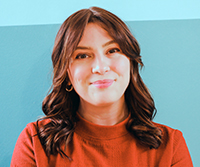 Third Place
Third Place
Katherine Atkinson
The Art of War
Originally from Indiana, my husband and I moved here in 2019 from Georgia. After graduating, I plan to pursue careers in art direction and screenwriting, but I’m also interested in obtaining my MLS to become a film archivist. I enjoy designing and building props, and I’m looking forward to learning new crafts and techniques.
Excerpt from submission
As with any artform, single works can have a multitude of interpretations, requiring precise search terms and specific language to prevent sifting through thousands of results. The first strategy I used was to keep my searches within the Film & Television Literature Index with Full Text and America: History & Life with Full Text databases …. I also used the American Film Scripts Online database in [librarian] Mark Emmons’ research guide to find the scripts of each film and ensure the dialog I analyzed was accurate. Some sources were immaterial to my topics, but their works cited led me to more appropriate information not in my initial searches....Using this tactic has helped me find older resources that had not been converted to a digital format or were in obscure or little-known books and journals….Without help from Mark Emmons and the collections provided by UNM Libraries website and InterLibrary Loan, I would not have been able execute this project so successfully.
Excerpt from Professor Angie Beauchamp letter of support
Katie’s research statement very clearly outlines her research process, which included using article databases, book chapters, articles on interlibrary loan, the script database, and streaming media (Lumiere). History of Film I is the course in which the Department of Film and Digital Arts really emphasizes research skills, and in the past, UNM film librarian Mark Emmons actually visited the class each fall semester to give a live session on all of the resources available for film students. Now his online Film Research Guide on the library website is shared with students and is a valuable tool. I can see how effectively Katie used so many of the resources provided there, especially in her synthesis of the work of other scholars with her direct analysis of the films found on streaming media at Lumiere and the dialogue source available in scripts.
Emerging Researcher Category
First Place
Hevyn L. Heckes
Missing and Murdered Indigenous Women (and Children) – A Global Problem
In Fall 2021, I covered an MMIW rally at Tiguex Park as a freelance reporter for the Daily Lobo. There I learned that Indigenous women are four times more likely to go missing and/or be murdered than I am (as a white woman). The final paper for Dr. Powers International Relations class offered an opportunity for me to explore this issue further, thereby educating myself regarding the global scope of MMIWR and its roots in destructive colonization. Dr. Desi Small-Rodriguez of UCLA, a leading Indigenous Data Scientist and board member of the Sovereign Bodies Institute (https://www.sovereign-bodies.org/), a nonprofit which works to overcome the lack of data that functions as an obstacle to achieving justice for MMIWR, helped me develop an understanding of the crisis through the All My Relations podcast, which she co-hosts. I would like to thank these scholars for their direct and indirect support of my research project. I hope someday, after much hard work, I'm even half as brilliant and accomplished as these inspirational women.
Excerpt from submission
When I began my research project, I sought to learn why Indigenous women and children are four times more likely to be victims of abduction and murder than I am. At that time, I had only a vague notion that climate change and the foster care system were somehow linked to the crisis. The resources made available to me through UNM Libraries helped me learn how extractive capitalism, jurisdictional barriers, and the paradigms of colonization contribute to the crisis... When the US Census Bureau yielded no digestible information, I used Research Guides and the EBSCO database to access statistics that had been used by Indigenous Politics scholars previously and were thus credible for use in my paper.
Excerpt from Professor Kathy Powers-Jordan letter of support
Hevyn is smart, hardworking, has vision, and is incredibly open to learning about new ideas and as well as sharing her own. As a returning student after several years in the workforce, she brings maturity, experience, and organizational knowledge that will help her make the most of this award. I have been one of her mentors since she arrived on campus and hope to continue to guide this bright student.
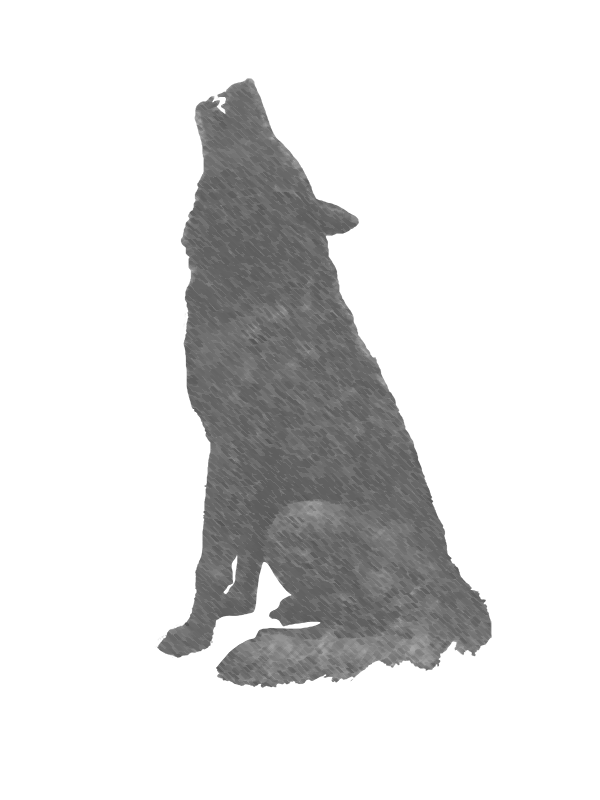 Second Place
Second Place
Colin M. Rankine
Asin Yahola's Wife
After 9 years as a senior massage therapist at the Nob Hill Spa in San Francisco, CA, Colin Rankine joined the University of New Mexico as a History major with a minor in Professional and Technical Communications. You may know his work from the newsletter and other PR materials at the UNM Art Museum, where he works as a Communications Assistant. Colin is also a certified forklift operator. He lives in Albuquerque with his partner.
Excerpt from submission
I had two overlapping concerns: the Seminole response to American incursion on their territory, and the identity of the Gullah Geechee people. I used information from Kly, Creel, and Pollitzer to approximate the diverse background of the Geechee people, including African Poro/Sande traditions, Islam, and Methodist conversion on American plantations. Drawing on Littlefield, Miller, Kly, and Twyman, I speculated on the political and social relationships among the Seminole and Geechee communities. To develop a multimodal composition, I built a non-linear format supplemented the text with images located in internet databases via wikicommons, the Library of Congress, the Smithsonian Art Museum, University of Georgia Libraries, the DeGolyer Library at Southern Methodist University in Texas, and the State Library and Archives of Florida.
Excerpt from Instructor Mikaela Osler letter of support
One element of this project that particularly impressed me was the variety of ways in which Colin employed archival artifacts. In previous projects, Colin demonstrated a robust ability to select and synthesize secondary sources and to engage thoughtfully with primary sources. In this project, he continued to employ sources as one would in a standard research project, but went above and beyond through his use of fiction and de-contextualization to draw attention to the research process. Implicit in this use of documents (and made explicit in the artist’s statement) was a thoughtful engagement with credibility of various sources.
 Third Place
Third Place
Haley G. Hughes
Mental Illness and Human Dignity in Jane Eyre
Haley Hughes is a student in the Combined BA/MD Program and a Regents' Scholar at the University of New Mexico, where she studies Health, Medicine, and Human Values. Upon completion of her studies, she plans to practice medicine in New Mexico, her home state. Haley's academic interests include addressing health disparities and barriers that impede access to quality healthcare. In her free time, she enjoys spending time with family, being involved in her local church, and trying new coffee recipes.
Excerpt from submission
After considering potential theses and consulting with the instructor, I decided I wanted to focus on Brontë’s approach to mental illness in her novel, considering what I had learned about her family history with her brother Branwell... I began my research by searching the MLA International Bibliography, which was available to me through the UNM Library... Following this, I searched with similar terms in the UNM Library Catalog search, which a UNM subject librarian had taught me about during a workshop in a different UNM course. I found more applicable results with this method, and I downloaded many potential articles, while requesting other articles through the InterLibrary Loan program.
Excerpt from Professor Renée Faubion letter of support
Part of the sophistication of Haley’s work lies in her ability to make appropriate use of Bronte’s biography. Biographical analysis can be a trap in literature studies, as such strategies can lead to a naïve, even rather flat, interpretation of the text. Instead, Haley’s work is quite sophisticated; she offers a rich reading of the novel, using Bronte’s biography to elaborate on the cultural context for Jane Eyre’s presentation of mental illness... Haley makes appropriate use of secondary scholarly sources, including discussions of Jane Eyre and considerations of attitudes toward mental illness at the time the novel was written.
